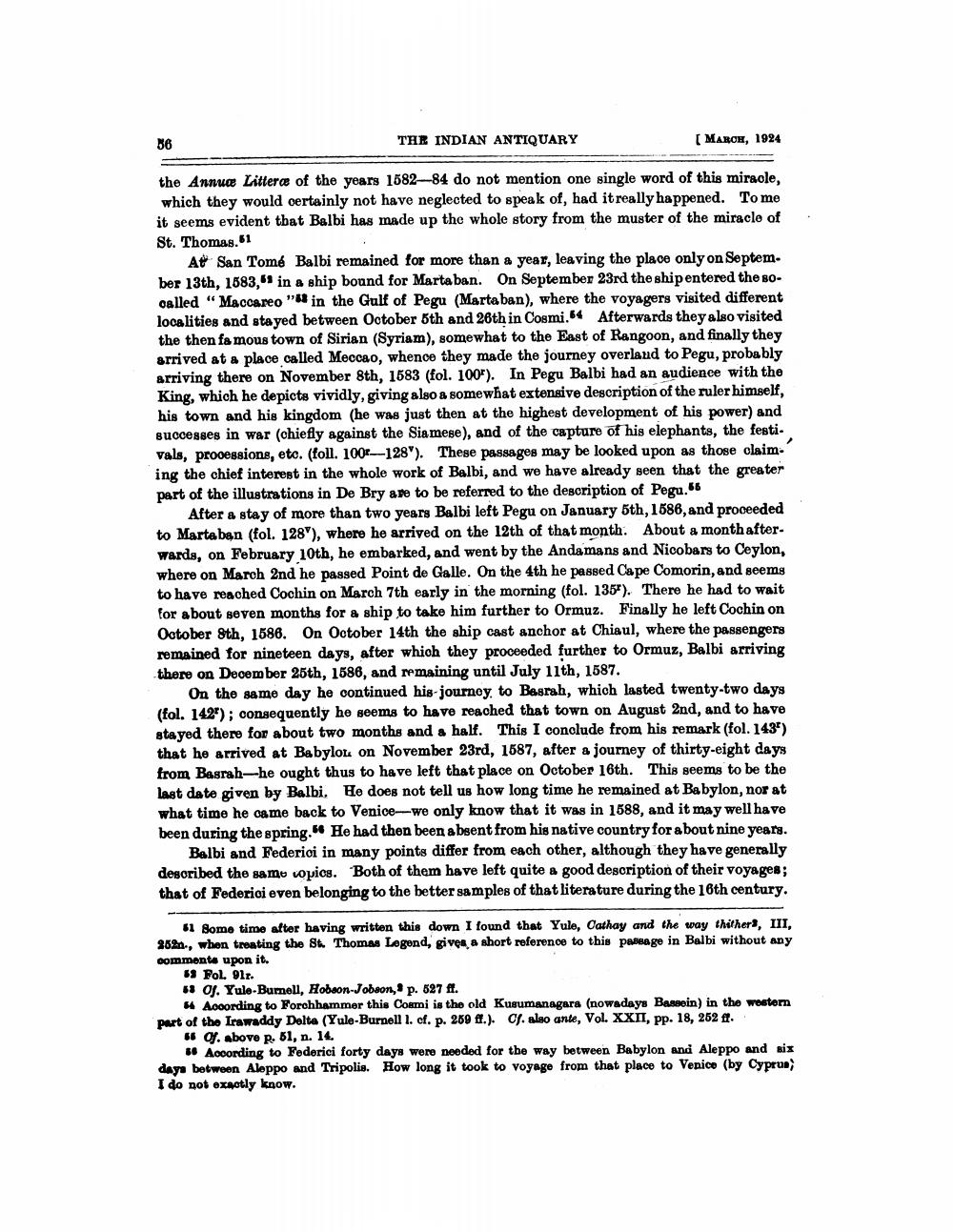________________
56
THE INDIAN ANTIQUARY
( MARCH, 1924
the Annuce Litteræ of the years 1582-84 do not mention one single word of this miracle, which they would certainly not have neglected to speak of, had it really happened. To me it seems evident that Balbi has made up the whole story from the muster of the miracle of St. Thomas. 51
At San Tomé Balbi remained for more than a year, leaving the place only on September 13th. 1883,61 in a ship bound for Marta ban. On September 23rd the ship entered the socalled "Maccareo "Hin the Gulf of Pegu (Martaban), where the voyagers visited different localities and stayed between October 5th and 26th in Cosmi." Afterwards they also visited the then famous town of Sirian (Syriam), somewhat to the East of Rangoon, and finally they arrived at a place called Meccao, whence they made the journey overlaud to Pegu, probably arriving there on November 8th, 1583 (fol. 100F). In Pegu Balbi had an audience with the King, which he depicts vividly, giving also a somewhat extensive description of the ruler himself, his town and his kingdom (he was just then at the highest development of his power) and successes in war (chiefly against the Siamese), and of the capture of his elephants, the festi. vals, processions, etc. (foll. 1001-128'). These passages may be looked upon as those claim.' ing the chief interest in the whole work of Balbi, and we have already seen that the greater part of the illustrations in De Bry are to be referred to the description of Pegu."
After a stay of more than two years Balbi left Pegu on January 5th, 1686, and proceeded to Martaban (fol. 128), where he arrived on the 12th of that month. About a month afterwards, on February 10th, he embarked, and went by the Andamans and Nicobars to Ceylon. where on March 2nd he passed Point de Galle. On the 4th he passed Cape Comorin, and seems to have reached Cochin on March 7th early in the morning (fol. 1354). There he had to wait for about seven months for a ship to take him further to Ormuz. Finally he left Cochin on October 8th, 1586. On October 14th the ship cast anchor at Chiaul, where the passengers remained for nineteen days, after which they proceeded further to Ormuz, Balbi arriving there on December 25th, 1586, and remaining until July 11th, 1587.
On the same day he continued his journey to Basrah, which lasted twenty-two days (fol. 142"); consequently he seems to have reached that town on August 2nd, and to have stayed there for about two months and a half. This I conclude from his remark (fol. 1434) that he arrived at Babylon on November 23rd, 1687, after a journey of thirty-eight days from Basrah-he ought thus to have left that place on October 16th. This seems to be the last date given by Balbi. He does not tell us how long time he remained at Babylon, nor at what time he oame back to Venice-we only know that it was in 1588, and it may well have been during the spring." He had then been absent from his native country for about nine years.
Balbi and Federici in many points differ from each other, although they have generally described the same pics. Both of them have left quite a good description of their voyages; that of Federici even belonging to the better samples of that literature during the 16th century.
51 some time after having written this down I found that Yule, Cathay and the way thithers, III, 362n., when treating the St. Thomas Legend, gives a short reference to this passage in Balbi without any comments upon it.
53 FOL 911. - Oj. Yule-Bumell, Hobson-Jobson, p. 627 ft.
4 Acoording to Forchhammer this Cormi is the old Kusumanagara (nowadays Bassein) in the westem part of the Irawaddy Dolta (Yule-Burnell l. cf. p. 259 ff.). Cf. also ante, Vol. XXII, pp. 18, 252 ft.
O. above p. 51, n. 14. ** According to Federici forty days were needed for the way between Babylon and Aleppo and six days between Aleppo and Tripolis. How long it took to voyage from that place to Venice (by Cyprus I do not exactly know.




